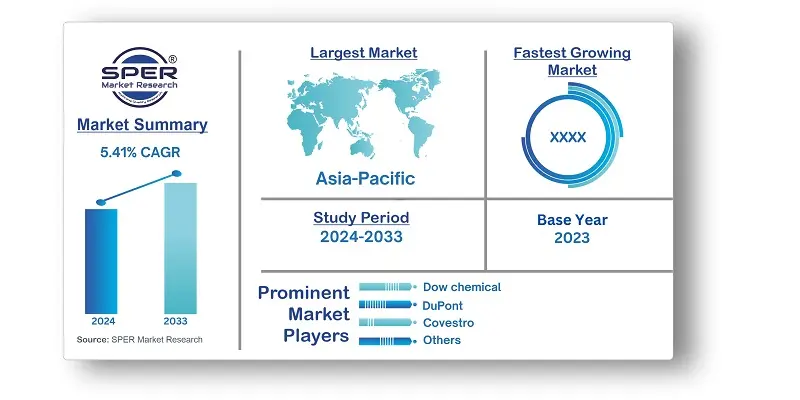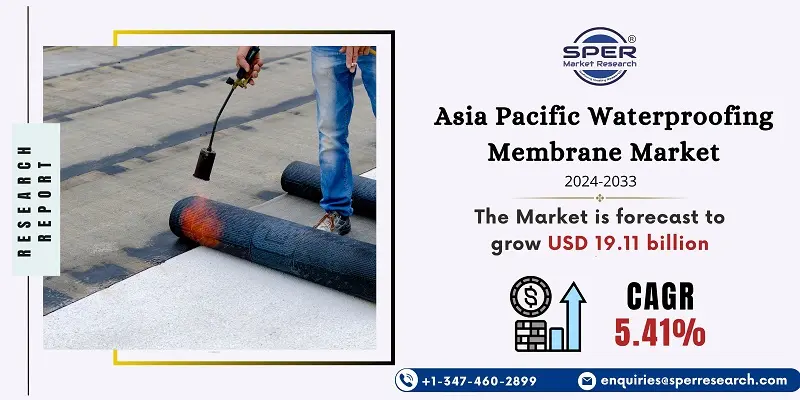
Asia Pacific Waterproofing Membrane Market Growth, Size, Trends, Revenue and Future Outlook
Asia Pacific Waterproofing Membrane Market Size- By Product, By End User- Regional Outlook, Competitive Strategies and Segment Forecast to 2033
| Published: Jun-2024 | Report ID: CHEM2468 | Pages: 1 - 155 | Formats*: |
| Category : Chemical & Materials | |||
- In May 2023: Oriental Yuhong and Hebei Aorun Shunda Group inked a strategic collaboration agreement to work together on multi-dimensional research in the areas of thermal insulation coatings and waterproofing membranes, among other solutions.
- May 2023: With the exception of its concrete admixture operations in Europe, North America, Australia, and New Zealand, Sika, a world leader in construction chemicals, acquired the MBCC Group, including its waterproofing solutions, flooring resins, anchors & grouts, repair & rehabilitation chemicals, and other businesses.
- March 2023: Oriental Yuhong and Luoyang Longfeng Construction Investment Co., Ltd. signed a strategic partnership agreement to expand Oriental Yuhong's line of building products, which includes waterproofing solutions. It is anticipated that this agreement will lead to a resource exchange for building supplies.


| Report Metric | Details |
| Market size available for years | 2020-2033 |
| Base year considered | 2023 |
| Forecast period | 2024-2033 |
| Segments covered | By Product, By End-Use |
| Regions covered | China, Japan, India, South Korea, Australia, Indonesia, Others |
| Companies Covered | Dow chemical, BASF, Sika AG, DuPont, Covestro, Pidilite, Fosroc, CICO Technologies, Mapie, Chryso SAS, Carlisle, Pentens, Tremco, Maris Polymer, Dyflex. |
- Construction Companies and Contractors
- Architects and Engineers
- Real Estate Developers
- Government Agencies and Municipalities
- Waterproofing Contractors and Applicators
- Industrial Facility Managers
- Distributors and Suppliers
- Property Owners and Managers
- Consultants and Industry Experts
| By Product: |
|
| By End Use: |
|
- Asia Pacific Waterproofing Membrane Market Size (FY’2024-FY’2033)
- Overview of Asia Pacific Waterproofing Membrane Market
- Segmentation of Asia Pacific Waterproofing Membrane Market By Product (Sheet Membranes, Liquid Membranes)
- Segmentation of Asia Pacific Waterproofing Membrane Market By End Use (Roof, Deck & Terrace, Car Park Deck, Garden Roof, Wall, Landfill & Tunnel, Wet Area, Pool, Basement)
- Statistical Snap of Asia Pacific Waterproofing Membrane Market
- Expansion Analysis of Asia Pacific Waterproofing Membrane Market
- Problems and Obstacles in Asia Pacific Waterproofing Membrane Market
- Competitive Landscape in the Asia Pacific Waterproofing Membrane Market
- Impact of COVID-19 and Demonetization on Asia Pacific Waterproofing Membrane Market
- Details on Current Investment in Asia Pacific Waterproofing Membrane Market
- Competitive Analysis of Asia Pacific Waterproofing Membrane Market
- Prominent Players in the Asia Pacific Waterproofing Membrane Market
- SWOT Analysis of Asia Pacific Waterproofing Membrane Market
- Asia Pacific Waterproofing Membrane Market Future Outlook and Projections (FY’2024-FY’2033)
- Recommendations from Analyst
1.1. Scope of the report1.2. Market segment analysis
2.1. Research data source
2.1.1. Secondary Data2.1.2. Primary Data2.1.3. SPER’s internal database2.1.4. Premium insight from KOL’s
2.2. Market size estimation
2.2.1. Top-down and Bottom-up approach
2.3. Data triangulation
4.1. Driver, Restraint, Opportunity and Challenges analysis
4.1.1. Drivers4.1.2. Restraints4.1.3. Opportunities4.1.4. Challenges
4.2. COVID-19 Impacts of the Asia Pacific Waterproofing Membrane Market
5.1. SWOT Analysis
5.1.1. Strengths5.1.2. Weaknesses5.1.3. Opportunities5.1.4. Threats
5.2. PESTEL Analysis
5.2.1. Political Landscape5.2.2. Economic Landscape5.2.3. Social Landscape5.2.4. Technological Landscape5.2.5. Environmental Landscape5.2.6. Legal Landscape
5.3. PORTER’s Five Forces
5.3.1. Bargaining power of suppliers5.3.2. Bargaining power of buyers5.3.3. Threat of Substitute5.3.4. Threat of new entrant5.3.5. Competitive rivalry
5.4. Heat Map Analysis
6.1. Asia Pacific Waterproofing Membrane Market Manufacturing Base Distribution, Sales Area, Product Type6.2. Mergers & Acquisitions, Partnerships, Product Launch, and Collaboration in Asia Pacific Waterproofing Membrane Market
7.1. Asia Pacific Waterproofing Membrane Market Size, Share and Forecast, By Product, 2020-20267.2. Asia Pacific Waterproofing Membrane Market Size, Share and Forecast, By Product, 2027-20337.3. Sheet membrane
7.3.1. Bitumen7.3.2. Ethylene propylene diene monomer (EPDM)7.3.3. Thermoplastic polyolefin (TPO)
7.4. Liquid membrane
7.4.1. Bitumen solvent7.4.2. Bitumen waterbase7.4.3. Polymer modified cement7.4.4. Polyacrylic7.4.5. Rapid cure system7.4.6. 1k PU solvent7.4.7. 2k PU solvent7.4.8. PU bend acrylic
8.1. Asia Pacific Waterproofing Membrane Market Size, Share and Forecast, By End Use, 2020-20268.2. Asia Pacific Waterproofing Membrane Market Size, Share and Forecast, By End Use, 2027-20338.3. Roof8.4. Deck and terrace8.5. Car park deck8.6. Wall8.7. Landfill & tunnel8.8. Wet area8.9. Pool8.10. Basement
9.1. Asia Pacific Waterproofing Membrane Market Size and Market Share
10.1. Asia Pacific Waterproofing Membrane Market Size and Market Share By Region (2020-2026)10.2. Asia Pacific Waterproofing Membrane Market Size and Market Share By Region (2027-2033)10.3. China10.4. Japan10.5. India10.6. South Korea10.7. Australia10.8. Indonesia10.9. Others
11.1. Dow chemical
11.1.1. Company details11.1.2. Financial outlook11.1.3. Product summary11.1.4. Recent developments
11.2. BASF
11.2.1. Company details11.2.2. Financial outlook11.2.3. Product summary11.2.4. Recent developments
11.3. Sika AG
11.3.1. Company details11.3.2. Financial outlook11.3.3. Product summary11.3.4. Recent developments
11.4. DuPont
11.4.1. Company details11.4.2. Financial outlook11.4.3. Product summary11.4.4. Recent developments
11.5. Covestro
11.5.1. Company details11.5.2. Financial outlook11.5.3. Product summary11.5.4. Recent developments
11.6. Pidilite
11.6.1. Company details11.6.2. Financial outlook11.6.3. Product summary11.6.4. Recent developments
11.7. Fosroc
11.7.1. Company details11.7.2. Financial outlook11.7.3. Product summary11.7.4. Recent developments
11.8. CICO Technologies
11.8.1. Company details11.8.2. Financial outlook11.8.3. Product summary11.8.4. Recent developments
11.9. Mapie
11.9.1. Company details11.9.2. Financial outlook11.9.3. Product summary11.9.4. Recent developments
11.10. Chryso SAS
11.10.1. Company details11.10.2. Financial outlook11.10.3. Product summary11.10.4. Recent developments
11.11. Carlisle
11.11.1. Company details11.11.2. Financial outlook11.11.3. Product summary11.11.4. Recent developments
11.12. Pentens
11.12.1. Company details11.12.2. Financial outlook11.12.3. Product summary11.12.4. Recent developments
11.13. Tremco
11.13.1. Company details11.13.2. Financial outlook11.13.3. Product summary11.13.4. Recent developments
11.14. Maris Polymer
11.14.1. Company details11.14.2. Financial outlook11.14.3. Product summary11.14.4. Recent developments
11.15. Dyflex
11.15.1. Company details11.15.2. Financial outlook11.15.3. Product summary11.15.4. Recent developments
11.16. Others
SPER Market Research’s methodology uses great emphasis on primary research to ensure that the market intelligence insights are up to date, reliable and accurate. Primary interviews are done with players involved in each phase of a supply chain to analyze the market forecasting. The secondary research method is used to help you fully understand how the future markets and the spending patterns look likes.
The report is based on in-depth qualitative and quantitative analysis of the Product Market. The quantitative analysis involves the application of various projection and sampling techniques. The qualitative analysis involves primary interviews, surveys, and vendor briefings. The data gathered as a result of these processes are validated through experts opinion. Our research methodology entails an ideal mixture of primary and secondary initiatives.



Frequently Asked Questions About This Report
PLACE AN ORDER
Year End Discount
Sample Report
Pre-Purchase Inquiry
NEED CUSTOMIZATION?
Request CustomizationCALL OR EMAIL US
100% Secure Payment






Related Reports
Our Global Clients
Our data-driven insights have influenced the strategy of 200+ reputed companies across the globe.




















